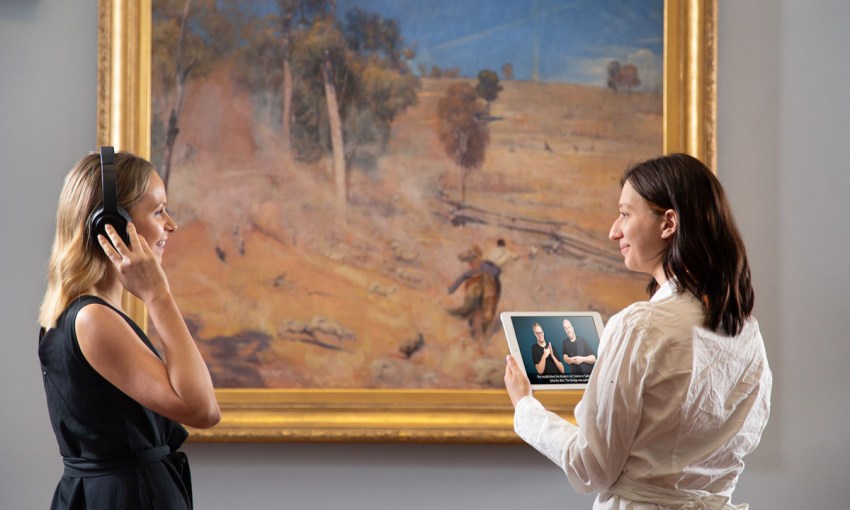CityMag sat down with Access2Arts, the Art Gallery of South Australia and the Adelaide Symphony Orchestra to discuss how the state’s most revered artistic institutions are opening the doors for a more diverse audience while making the experience richer for everyone.
How Adelaide’s peak artistic organisations are making the arts accessible to all
According to Bec Young, Chief Executive of Access2Arts, a disability-led organisation working to break down barriers that exist between disabled people and the creative industries, “disability is not a universal experience. Everyone’s lived experience is unique to themselves”.
James Murphy is currently Writer-in-Residence at The Mill.
This article was published in partnership with The Mill as part of its Writer-in-Residence program.
For more information on the program, see here.
Disability access is often, wrongly, given its most narrow construction: a ramp at the entrance, perhaps an AUSLAN interpreter for the hearing impaired.
The Adelaide Symphony Orchestra (ASO) and the Art Gallery of South Australia (AGSA), though, have recognised that facilitating entry into the venue is a gateway into addressing broader access needs. Introducing interpreters or audio descriptions into their operations was just an icebreaker, starting the conversation regarding how to best communicate with diverse audiences.
When the Adelaide Symphony Orchestra began designing their Relaxed Concerts series, in partnership with City of Adelaide and Beyond Bank, they did so in collaboration with some of the state’s peak disability organisations, including event partners Can Do: 4 Kids, Access2Arts and Tutti Arts, as ASO’s Community Projects Manager Elizabeth McCall explains.
“We’re quite experienced at delivering family concerts, so we went, ‘Ok, what barriers do we need to remove?’” Elizabeth says.
“We wanted to get input from a number of partners with different perspectives. Can:Do came on board to help us think about the layout of the space, the lighting, the breakout spaces, and we got some advice from Autism SA about how to set up those spaces.
“Access2Arts were very helpful in preparing a visual story book for families, which they can download before the concert, which gives them a really clear idea about what they can expect when they arrive, what they’ll see when the walk in, what the musicians will do – such as at the end [the musicians] will stand up and then you clap. Really laying out every step of the concert.”

An Adelaide Symphony Orchestra Concert at Town Hall. This image: Jessica Clark
In 2019, AGSA introduced deaf-led tours for Tarnanthi, and started work on a program for people with dementia. The next year, the gallery expanded its scope by producing an Accessible Guide for the Elder Wing of Australian Art.
The guide, produced in-house by an AGSA employee trained by Access2Arts and honed through consultation with the vision- and hearing-impaired community, harnessed the audience’s smartphones and tablets to improve access.
In December this year, AGSA aims to release their next project, a plain English version of the Accessible Guide, produced by Access2Arts.
“Lots of descriptions in art galleries and museums are written in what I would term high English. We’re really looking at changing the way that we write into clearer terms,” explains Bec.
“It’s not about dumbing things down; it’s about writing things in clear language that the everyday person on the street will understand but that also may be accessible for [the learning disabled] or for people who may have English as a second language.”
Access2Arts similarly assisted the ASO to simplify its descriptions for the Relaxed Concerts’ visual story book.
“We’re so used to talking about orchestral concerts in our language, which can be quite flowery, and [Access2Arts] really helped us cut to the chase,” Elizabeth says.

L—R: Xanthe the Dog with Access2Arts’ Jody Holdback, Manager, Access and Inclusion Services, and Bec Young, Chief Executive
By integrating accessibility from the ground up, both the AGSA and ASO hope to create positive first exposures to their respective art forms, which will hopefully foster lifelong affinities.
“The great thing about improving access is that it actually increases audiences for all forms of the arts, so a young person who attends a Relaxed Concert as a child is more likely to feel inclined to experience and expose themselves to different forms of art if they’ve had a good experience,” Bec explains.
Increasing accessibility not only introduces new audiences to the arts, it also keeps those who have been devotees across their lifespan attending when their accessibility needs change.
“Audio descriptions are primarily accessed by people who are blind or have low vision, but people whose eyesight is declining are now enquiring about description services because they have been coming to shows for years and years but they’re becoming less engaged with it [because of vision decline],” Bec says.
By using their resources to blaze a new path, both the Art Gallery and the ASO hope to share their knowledge and learnings with other arts organisations in the state.
As AGSA Education Support Officer Karina Morgan explains, the gallery is a member of the Arts Access Precinct Group, along with the SA Museum, The Migration Museum, Samstag, ACE Open and MOD.
“Each of us talk about what’s happening in our institution and then someone else might ask, ‘Well, how did you do that?’ and we can provide feedback and help each other improve in that way,” Karina says.
“I’ve had a lot of interaction with ACE Open and assisting them with their programs, particularly with the deaf and hard of hearing community.”
While both AGSA and the ASO have taken strides towards universal access, they recognise the need for continual improvement and consultation with organisations like Access2Arts.
To inform their advocacy, Access2Arts is currently seeking disabled people’s stories of positive and negative interactions with arts access.
Bec encourages people to get in touch, either via the website, on social media or by email.




